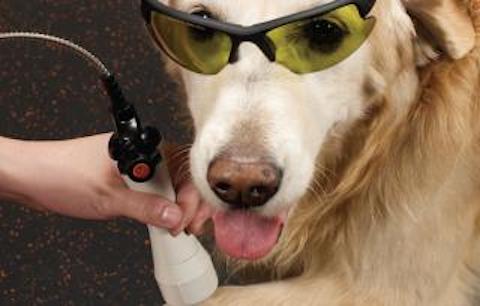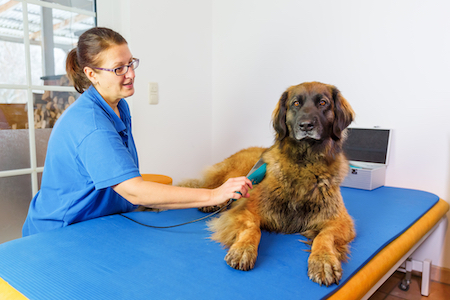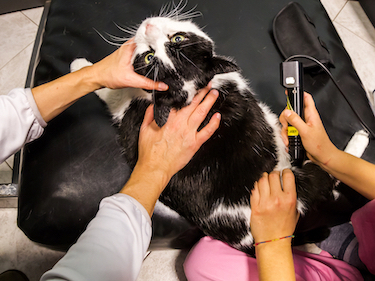If you’re a pet owner, you know that they are members of the family. And like any other member of the family, pets sometimes get sick or injured. When this happens, it’s essential to seek treatment for them as soon as possible. One treatment option that is growing in popularity is laser therapy. This blog post will discuss the benefits of laser treatment and how it can help your furkid heal quickly and effectively.

What is veterinary laser therapy?
Laser therapy, also called cold laser therapy, is an innovative treatment that has gained popularity in recent years as veterinarians discover its benefits for pets. As with other alternative therapies, laser treatment can be used instead of medication to manage pain inflammation and encourage faster wound healing.
Lasers stimulate tissue healing by increasing blood flow and promoting cell regeneration. Many veterinarians and pet parents are turning to this treatment method. Laser therapy is non invasive, pain free, and gives dogs and cats a better quality of life.

How does cold laser therapy work?
Cold lasers are low-level lasers that work by producing light waves that penetrate gently into tissue. These gentle pressures cause changes in individual cells, including the enzymes inside them and their cell membranes, as well as mitochondria. The laser stimulates your pet’s body to produce a naturally-occurring substance called adenosine triphosphate (ATP). ATP is what cells use for energy to help the body heal itself.
Wound healing is stimulated by ATP, which means that the injured cells get healthier and inflammation decreases. Ultimately, this tool leads to a faster healing process that promotes pain relief. Additionally, laser treatments have been shown to help increase vital functions like metabolism, nerve function, and circulation.
The vet will gently place the laser wand directly over the injured or affected areas. If the injury is too sensitive, they will put the wand close to it but not touch the skin. Laser therapy treatments are very relaxing for pets, often causing them to fall asleep. The warmth of the laser treatment spreads through their bodies and helps them feel better by alleviating pain or inflammation.
Laser therapy is a safe and effective way to reduce pain for your furkid. It can provide relief from surgery, trauma injuries, and aches caused by hip dysplasia and arthritis, all without side effects.

What conditions can laser therapy be used to treat?
Laser treatments help with a wide variety of medical concerns. Here are just some of the conditions that laser therapy can treat:
- degenerative disc disease
- cancer pain
- osteoarthritis and joint pain
- hip and elbow dysplasia
- bladder infection and disease
- anal gland infections
- burns
- broken bones
- periodontal disease, especially gingivitis and stomatitis
- cystitis
- acute and chronic otitis
- rhinitis and sinusitis
- musculoskeletal pain, including ligaments and tendons
- respiratory issues
- inflammatory skin disorders, including lick granulomas and hot spots
- neck injuries
- fractures
- inflammatory bowel disease
- back pain
- ear infections
- urinary tract infections
- soft tissue trauma
- tendon injuries
- post-surgical healing and decreasing nerve sensitivity
According to Lasers in Medical Science, a 2020 study found that low-level laser therapy reduces pain and accelerates tissue repair for a faster healing process.
The laser beam is a non-invasive and side-effect-free treatment. Pets remain calm during the session because all they feel is a gentle and soothing warmth, not pain. Your furry friend could recover quickly from surgery or traumatic injury thanks to veterinary laser therapy treatment, which eases their aches by providing relief and reducing inflammation caused by soreness with minimal medication.

How many treatments does my pet need?
The goal of cold laser treatments for dogs and cats is to help provide pain relief through drug free treatment. Because every animal has different needs, the number of therapy sessions will vary depending on the severity of the cat or dog’s illness or medical issue. Laser therapy is an effective treatment for both acute and chronic problems. With laser therapy, 6 to 10 treatments may be all that’s needed if the pet is due to illness or trauma. However, for furry companions with more severe injuries or diseases, 14 to 15 sessions may be necessary before pain relief is achieved.
Speak with your veterinarian about how many sessions they think would be appropriate for your pet’s aches and pains. The veterinary staff will develop a sufficient laser treatment schedule for you and your furkid.

Is laser therapy right for my pet?
Dog and cat parents may want to consider laser therapy for their dog or cat if they exhibit any of the following behaviors:
- trembling
- abnormal sitting or lying posture
- restlessness
- (for dogs) circling multiple times before lying down
- vocalizations such as groaning and whining
- limping
- lethargy
- depression
- unable to get up and down
- lack of appetite
- difficulty walking downstairs or getting into a car
- biting or licking areas of the body
- (for dogs) refusal to wag the tail
- lack of grooming
Talk with your veterinarian if you decide to have veterinary laser therapy treatments done on your four-legged friend. They will arrange for your pup or kitty to have an examination. A qualified veterinarian and veterinary technician will discuss your pet’s specific ailment. They can then tailor the session to fit your pet’s needs and recommend how many treatments are needed.

Cover alternate therapies with pet insurance.
Could your cat or dog use laser therapy to promote quicker healing and eliminate pain and inflammation? Are you worried that the treatments will cost too much? Most pet insurance providers now cover alternative therapies like laser therapy. That means you can afford laser therapy for your cat or dog. Depending on your pet insurance plan, your provider will reimburse you up to 90% of the session costs. Many laser therapy sessions cost anywhere from $40 to $100 per treatment. Depending on the medical issue, that cost can skyrocket quickly for multiple treatments.
Let Pet Insurance Review help you find a pet insurance policy that includes laser therapy coverage. Fill out a free quote today, and give your dog or cat a better quality of life.
References:
- Baum, I. (2021). Everything to Know About Cold Laser Therapy, Which Can Speed Recovery and Relieve Pain. Retrieved from https://www.wellandgood.com/cold-laser-therapy/
- Cheriyedath, S. (2019). Adenosine Triphosphate (ATP) Function in Cells. Retrieved from https://www.news-medical.net/life-sciences/Adenosine-Triphosphate-(ATP)-Function-in-Cells.asp
- Fesseha, H. (2020). Laser Therapy and its Potential Application in Veterinary Practice. Retrieved from https://www.heraldopenaccess.us/article_pdf/43/laser-therapy-and-its-potential-application-in-veterinary-practice-a-review.pdf
- Galesburg Animal Hospital. (2021). Laser Therapy for Pets. Retrieved from https://www.galesburganimalhospital.com/laser_therapy
- Lemos, G. A., et al. (2020). Photobiostimulation activity of different low-level laser dosage on masticatory muscles and temporomandibular joint in an induced arthritis rat model. Retrieved from https://pubmed.ncbi.nlm.nih.gov/31834562/
- Harmony Animal Hospital. (2014). Laser Therapy for Pets: What Does It Offer Your Animals? Retrieved from https://www.harmonyanimalhospital.net/pet-laser-therapy-offer-animals/
- Larson, H. (2019). Laser Therapy for Dogs. Retrieved from https://www.petmd.com/dog/care/laser-therapy-dogs
The information contained on this blog is intended for informational and educational purposes only and should not be construed as medical advice. It is not a substitute for professional veterinary care. Always consult with your veterinarian before making any changes to your pet's health care or treatment plan.
The authors of this blog are not veterinarians and do not claim to be experts in pet health. The information provided here is based on our own experiences and research, as well as information from reputable sources. However, we cannot guarantee the accuracy or completeness of this information.
We encourage you to do your own research and consult with your veterinarian before making any decisions about your pet's health.
Previous post
How to Recognize a Real Pet EmergencyNext post
Make Moving With Your Dog EasierCompare top pet insurance providers & plans.
Enter your dog’s age in years and months to calculate their age equivalent to human years.
Calculate your dog’s ageEnter your cat’s age in years and months to calculate their age equivalent to human years.
Calculate your cat’s age